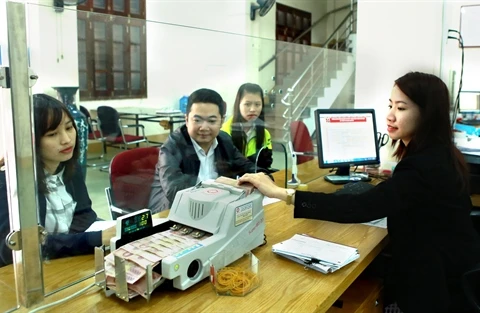Hanoi (VNA) – Credit this year will flow more into production and business instead of non-production industries as done previously, experts said.
In the latest report on prospects of the banking industry released this week, analysts of Vietcombank Securities (VCBS) forecast that credit growth this year would be roughly 16 percent, lower than the 18 percent rate of last year, because credit would focus more on production and business.
“After the steep rise in 2015, credit to construction, real estate and BOT projects can be levelled off this year due to both market conditions and the orientation from the central bank,” the analysts said.
The central bank this year will issue the amended Circular No 36, which is aimed at ensuring the safety of the banking system, curbing the risk of a real estate bubble, and orienting the credit flow to production and business.
According to the draft amendments, banks and foreign bank branches must reduce the proportion of short-term funding from 60 percent to 40 percent and from 200 percent to 80 percent at non-banking financial institutions. It also requires an increase in risk ratios for receivables from real estate activities from 150 percent to 250 percent.
The central bank said since 2015, the real estate market has been in a period of recovery with the help of various support measures, including the 30 trillion VND (1.3 billion USD) housing credit support package and the reduction of the ratio of short-term loans to medium- and long-term loans from 250 to 150 percent, thus allowing banks to extend medium- and long-term credit.
Moreover, the increase in medium- and long-term outstanding credit will put pressure on interest rates. The International Monetary Fund has warned Vietnam about its outstanding credit for real estate.
Deputy Chief Inspector of the State Bank of Vietnam Pham Huyen Anh said that as long-term investment is needed for business and production activities, including bank operations, medium- and long-term loans must flow to safer purposes and follow the direction of the country’s socio-economic development plan.
According to VCBS, the upcoming policy to tighten lending on real estate will slow down credit growth, contributing to easing of liquidity, reducing pressure on interest rates and stabilising them in accordance with the government’s orientation.
“The amendment can cause a negative impact on commercial banks in the short term such as pressure on medium- and long-term capital mobilisation. However, in the long term, the banking system will become more safe and credit will flow to production and business that are short of capital despite creating high value for the economy,” the analysts said.
VCBS said the interest rate this year is under pressure as credit might continuously outstrip deposits while inflation is expected to be higher than last year at 2.5 percent.
It forecast that with a rise of less than 50 percentage points, the deposit interest rate this year will touch the cap of 5.5 percent set for short-term tenors by the central bank.
Head of VCBS’s analysis division Tran Tuan Anh also expected the central bank to continuously keep a cap in order to control the lending interest rate and orient credit institutions to restructure their capital source with a rise in long-term deposits in context of rising needs for medium- and long-term loans.-VNA

























